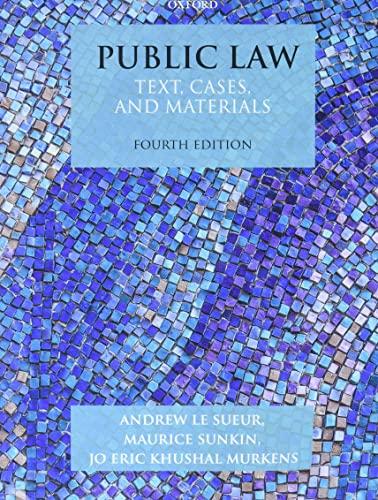Question
Please help me respond to this discussion post. The four sources of law would be the constitution, federal and state statutes/legislation, administrative law, and procedures
Please help me respond to this discussion post.
The four sources of law would be the constitution, federal and state statutes/legislation, administrative law, and procedures & judicial decisions. A constitution states the grounding legal and democratic principles that its government is obligated to uphold, it is referred to as the supreme law of the land because it sets standards against which all other laws are judged. A statute is a positive law enacted by a legislature to govern society, and its authority is derived from the constitution or founding document of a country, which authorizes the legislature to enact it. Administrative law deals with the rules of government agencies. Administrative law is the source of much of the substantive law that directly affects the rights and duties of individuals and businesses and their relation to governmental authority. Lastly, procedures describe the required steps necessary to complete a process and are generally written by an administrative body to ensure that the law and regulations are applied consistently and fairly to all parties.
Because our federal system is covered by national, state, and local jurisdictions, the legislative body may be the US Congress, a state legislature, or a deliberative assembly of local governments. Actions by any of these bodies can apply to healthcare organizations. For example, hospitals must comply with federal statutes such as the Civil Rights Act of 1964 and the Hill-Burton Act, which prohibit discrimination at patient admission. Most states and several large cities have also enacted antidiscrimination statutes. Also, Stark and Anti-Kickback Reform.CMS and the Department of Health and Human Services Office of Inspector General in November 2020 finalized eagerly awaited changes to the Stark Law and Anti-Kickback Statute regulations, which were proposed in October 2019. The final rules represent a significant overhaul of the Stark Law and Anti-Kickback Statute regulations. Notably, CMS and OIG have adopted new exceptions and safe harbors intended to accelerate health care's transition to value-based reimbursement and coordinated care. The Stark final rule also clarifies key requirements for compliance, commercial reasonableness, and the prohibition on considering the volume or value of a physician's referrals. Many of the interpretations and positions in the final rules may impact future enforcement trends and ongoing False Claims Act whistleblower actions.
Zimmerman, E., Wolfe, J., Maide, T., Hunter, D., Levine, S., Shah, A., Scarola, E., McClary, T., Adipat, R., Abramson, B. D., DeLoss, G., Akridge, C., Burrus, E. D., & Nelson, L. M. (2021). Top Ten Issues in Health Law 2021. Health Law Connections, 2(1). Retrieved August 21, 2022, from https://www.americanhealthlaw.org/content-library/connections-magazine/article/bbcd0c57-0da4-4d16-adbe-c997605ecea2/top-ten-issues-in-health-law.
Step by Step Solution
There are 3 Steps involved in it
Step: 1

Get Instant Access to Expert-Tailored Solutions
See step-by-step solutions with expert insights and AI powered tools for academic success
Step: 2

Step: 3

Ace Your Homework with AI
Get the answers you need in no time with our AI-driven, step-by-step assistance
Get Started


